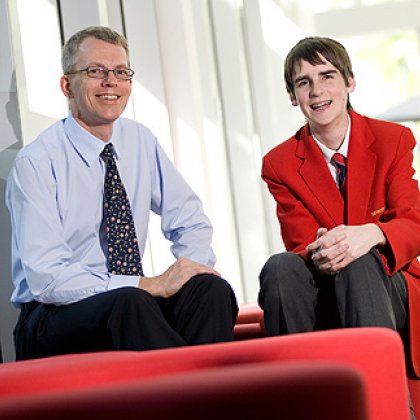
What began as a nationwide contest to encourage an interest in astronomy has ended with a tour of one of the world’s largest telescopes in Hawaii – all without leaving Brisbane.
Students from Forest Lake College, in Brisbane’s south, recently travelled to The University of Queensland for a video link up to the Gemini North Telescope’s remote control room, situated at sea level headquarters in Hawaii at the foot of Mauna Kea Volcano.
Professor Michael Drinkwater, from UQ’s School of Maths and Physics, said the video link allowed the students to join a Gemini Observatory astronomer live from the control room and experience real science in a genuine observatory environment.
“The video link started with a multi-media overview of the observatory, followed by some recent science highlights and ended with a live Q&A session with the astronomer Peter Michaud,” he said.
“Questions from the students to Peter ranged from 'what discoveries have you made?', through to 'how do you clean the telescope mirror' and, of course, 'do you think there’s other life out there in the universe?'
“It was a great opportunity for the kids, for anyone. The Gemini Observatory is an international collaboration that has built two identical eight metre telescopes.”
“The telescopes are located at Cerro Pachón in central Chile (Gemini South) and Mauna Kea in Hawaii (Gemini North), hence providing full coverage of both hemispheres of the sky.
“Both telescopes incorporate new technologies that allow large, relatively thin mirrors under active control to collect and focus both optical and infrared radiation from space.”
The video link was a prize for the first three place-getters in the 2009 Gemini School Astronomy Contest, run by the Australian Gemini Office.
Students were asked to select an object in the southern sky and write an explanation of why it would be interesting to digitally photograph, with the winner having their chosen object photographed using the telescope.
Forest Lake College entry Captain Stewart Wright said his team’s runners-up entry was for the super-massive star Eta Carinae.
“Eta Carinae is more than 8000 light-years away. About 150 years ago, it suffered a giant outburst and became one of the brightest stars in the southern sky,” Mr Wright said.
“Though the star released as much visible light as a supernova explosion, it survived the outburst. The explosion produced two lobes and a large, thin equatorial disk, all moving outward at about 2.5 million kilometres per hour.”
“It’s also interesting because Eta Carinae may be one of the most massive stars in our galaxy, it’s estimated to be 100 times heftier than our sun.”
A current Year 12 student studying mostly history and geography, Mr Wright said he’d always had a passion for astronomy.
“I’ve got my own telescope at home so I try to get involved whenever I can. I don’t get involved every night, but I try to get out every couple of weeks and have a good look,” he said.
“Especially now that Jupiter’s up, every so often we get out as it’s getting higher because with Saturn and Jupiter you’ve got the moons that are at different positions each time, and so it’s a continuous interest.
“But it’s not the type of thing you look at every night, it’s the type of thing I do ever couple of nights, every couple of weeks, as things change over time.”
He said he was thrilled to be able to come to UQ and link up with one of the world’s leading observatories.
“The video link up was excellent. Because before this I didn’t really know about the Gemini telescope and now I know plenty about it.
“Telescopes are like a time machine, they allow you to look back millions, even billions of years into the past.”
Media: Associate Professor Michael Drinkwater (07 33653428 or mjd@physics.uq.edu.au) or Lynelle Ross (07 33469935 or n.ross@sps.uq.edu.au).
About Gemini:
Giant modern telescopes such as Gemini North and Gemini South cost around A$100 million or more each. As such, they are too expensive for most universities or individual countries to own and operate. Instead, they are typically built and run by international consortia. Gemini is built and run by an international partnership of Australia, the USA, UK, Canada, Argentina, Brazil, and Chile. It has two offices, one in Hilo, Hawaii, the other in La Serena, Chile. Astronomers and engineers from all these countries helped design and build the telescopes, and astronomers from all these countries get to use them. Each partner country has a national Gemini office which supports users in that country. The Gemini Observatory partners, funding agencies, and partner shares are currently:
• USA (National Science Foundation) - 50.1%
• UK (Science & Technology Facilities Council) - 23.8%
• Canada (National Research Council) - 15.0%
• Australia (Australian Research Council) - 6.2%
• Brazil (Ministério da Ciência e Tecnologia) - 2.4%
• Argentina (Ministerio de Ciencia, Tecnología e Innovación Productiva) - 2.5%
The partner share of each country reflects how much they pay towards building and running the telescopes, and dictates the share of the telescope time that astronomers from that country get. In addition, some telescope time goes to Gemini staff, to the Director of the Gemini Observatory, and to the telescope hosts, in return for providing the telescopes their homes: the University of Hawaii for Gemini North, and Chile for Gemini South. Some telescope time is also reserved for engineering work, commissioning new instruments, and as a reward for instrument builders.
.jpg)


